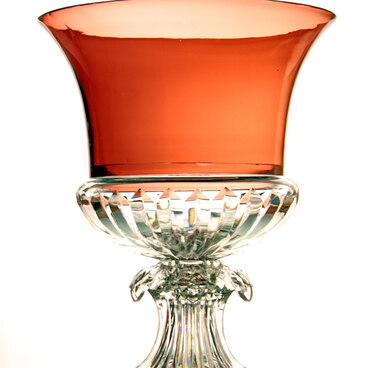The exhibition of the Dyatkovo Crystal Museum houses a treasured item — a copy of the present to the Gus Crystal Factory. The history of the Dyatkovo Crystal Factory is inextricably linked with the enterprise in the town of Gus-Khrustalny and the Maltsov dynasty — the famous industrialists and patrons of art.
Vasily Maltsov founded one of the family’s first glass manufacturing factories in the Mozhaysky Uyezd near Moscow in 1723. In the 1740s and 1750s, the Governing Senate issued orders to close distilleries, copper, iron and glass works within approximately 130 miles of Moscow for the purposes of forest conservation. The sons of the crystal factory’s owner Akim and Alexander divided the company into two parts. The first one was transferred to the Vladimir Governorate where they founded the Gus Crystal Factory in 1756. The second part was moved to the small village of Dyatkovo in the Bryansk Uyezd where they founded the Dyatkovo Factory in 1790. Therefore, both enterprises belonged to the extended Maltsov family. Apart from establishing the foundation and traditions of the distinctive Russian school of glass art, the factories formed the basis of two unique art collections: the Dyatkovo Crystal Museum in Dyatkovo and the Maltsov Crystal Museum in Gus-Khrustalny. Over two centuries, the factories worked and developed their operations side by side, shared their best practices with each other, participated in various international competitions and exhibitions, and received Russian and international prizes and awards.
In 1956, the factory in Gus-Khrustalny celebrated its 200th anniversary. To mark this special occasion, the craftsmen of the Dyatkovo Crystal Factory prepared a gift that was bright, unique, and strikingly beautiful. It was a decorative vase made of green glass. The vase consists of several parts. Such large items are usually made of components that are produced separately because it is almost impossible to blow such a product as one piece. The vase is decorated with gold painting and gold embossing. These techniques are based on using liquid gold solutions. The gold embossing technique involves using acid to create etched matte areas within a bright gold border and applying glossy gold images to such areas.
Vasily Maltsov founded one of the family’s first glass manufacturing factories in the Mozhaysky Uyezd near Moscow in 1723. In the 1740s and 1750s, the Governing Senate issued orders to close distilleries, copper, iron and glass works within approximately 130 miles of Moscow for the purposes of forest conservation. The sons of the crystal factory’s owner Akim and Alexander divided the company into two parts. The first one was transferred to the Vladimir Governorate where they founded the Gus Crystal Factory in 1756. The second part was moved to the small village of Dyatkovo in the Bryansk Uyezd where they founded the Dyatkovo Factory in 1790. Therefore, both enterprises belonged to the extended Maltsov family. Apart from establishing the foundation and traditions of the distinctive Russian school of glass art, the factories formed the basis of two unique art collections: the Dyatkovo Crystal Museum in Dyatkovo and the Maltsov Crystal Museum in Gus-Khrustalny. Over two centuries, the factories worked and developed their operations side by side, shared their best practices with each other, participated in various international competitions and exhibitions, and received Russian and international prizes and awards.
In 1956, the factory in Gus-Khrustalny celebrated its 200th anniversary. To mark this special occasion, the craftsmen of the Dyatkovo Crystal Factory prepared a gift that was bright, unique, and strikingly beautiful. It was a decorative vase made of green glass. The vase consists of several parts. Such large items are usually made of components that are produced separately because it is almost impossible to blow such a product as one piece. The vase is decorated with gold painting and gold embossing. These techniques are based on using liquid gold solutions. The gold embossing technique involves using acid to create etched matte areas within a bright gold border and applying glossy gold images to such areas.







